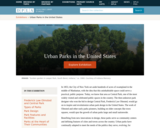
In 1853, the City of New York set aside hundreds of acres of swampland in the middle of Manhattan, with the idea that this uninhabitable space could serve a practical, public purpose. Today, we know that area as Central Park, one of the most widely visited and celebrated public spaces in the country. The then-unknown park designer who won the bid to design Central Park, Frederick Law Olmsted, would go on to inspire and revolutionize urban park design in the United States. The work of Olmsted and other early parks pioneers, building on older concepts like town squares, would spur the growth of urban parks large and small nationwide. Benefiting from new innovations in design, these parks serve as community centers and defining features of cities and towns across the country. Urban parks have continually adapted to meet the needs of the publics they serve, evolving, for example, from places to simply enjoy nature into recreation sites that offer activities and equipment. More than just sites for leisure, they also play a broader role in supporting community engagement by providing places for civic participation, enhancing quality of life and property values, and offering safe, healthy, and convenient recreation options. This exhibition was created as part of the DPLAs Public Library Partnerships Project by collaborators from the Minnesota Digital Library. Exhibition Coordinator: Carla Urban.
- Subject:
- History
- U.S. History
- Material Type:
- Diagram/Illustration
- Primary Source
- Unit of Study
- Provider:
- Digital Public Library of America
- Provider Set:
- DPLA Exhibitions
- Date Added:
- 09/01/2015